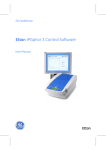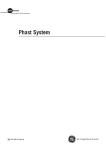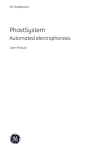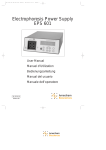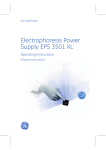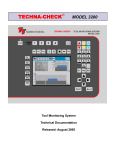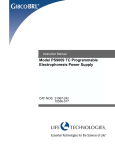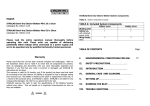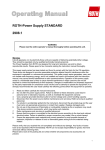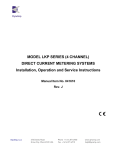Download Electrophoresis Power Supply User Manual EPS 3500
Transcript
P H A R M A C I A B I O T E C H Electrophoresis Power Supply EPS 3500 User Manual 19-3500-05 Edition AB Pharmacia Biotech Important user information Reading this entire manual is necessary for full understanding and safe use of this product. The exclamation mark within an equilateral triangle is intended to alert the user to the presence of important operating and maintenance instructions in the literature accompanying the instrument. The lightning symbol within an equilateral triangle is intended to alert the user to the risk of exposure to high voltages. Should you have any comments on this manual, we will be pleased to receive them at: Pharmacia Biotech AB S-751 82 Uppsala Sweden Pharmacia Biotech reserves the right to make changes in the specifications without prior notice. Warranty and Liability Pharmacia Biotech AB guarantees that the product delivered has been thoroughly tested to ensure that it meets its published specifications. The warranty included in the conditions of delivery is valid only if the product has been installed and used according to the instructions supplied by Pharmacia Biotech AB. Pharmacia Biotech AB shall in no event be liable for incidental or consequential damages, including without limitation, lost profits, loss of income, loss of business opportunities, loss of use and other related exposures, however caused, arising from the faulty and incorrect use of the product. Copyright© 1994 Pharmacia Biotech AB All rights reserved. No part of this publication may be reproduced, stored in a retrieval system or transmitted in any form by any means, without permission in written form from the company. Contents 1. Introduction ............................................................................................. 3 2. Safety information .................................................................................. 4 2.1 Safety precautions ........................................................................ 4 2.2 In-built safety features ................................................................. 4 3. Unpacking and installation................................................................... 5 4. Technical description ............................................................................. 6 4.1 Front panel .................................................................................... 6 4.1.1 Display ................................................................................. 6 4.1.2 Keyboard ............................................................................. 6 4.1.3 Output sockets ................................................................... 8 4.2 Rear panel ...................................................................................... 8 5. Operation ................................................................................................. 9 5.1 Overview ....................................................................................... 9 5.2 Programming ................................................................................ 9 5.3 Running a program ................................................................... 11 5.4 Optional programming ............................................................. 13 5.5 Choosing run parameters ......................................................... 14 5.6 Short instructions ....................................................................... 16 6. Maintenance .......................................................................................... 17 7. Trouble shooting ................................................................................... 18 8. Technical specifications ........................................................................ 19 9. Ordering information .......................................................................... 20 2 1. Introduction 1. Introduction The Pharmacia Electrophoresis Power Supply EPS 3500 is a high quality, high precision and safe power supply for electrophoresis applications that require a maximum of 3500 volts. EPS 3500 is primarily designed for the following techniques: ● ● DNA sequencing IEF (Isoelectric focusing) EPS 3500 is also suitable for: ● ● SDS-PAGE (Polyacrylamide Gel Electrophoresis) Native PAGE ● Agarose electrophoresis ● Electroblotting DNA pulsed field electrophoresis ● Electrophoresis separations can be controlled by voltage, current or power. The EPS 3500 automatically switches over the controlling parameter according to programmed limits and conductivity variations in the system. Two electrophoresis units can be connected to the EPS 3500 and run with the same programmed method at one time. Three programs can be saved. 3 2. Safety information 2. Safety information 2.1 Safety precautions Extreme caution should be exercised in the operation of this instrument as it can develop sufficient voltage and current to produce a lethal shock. To avoid any risk of injury, the instrument should only be operated by properly trained personnel and always in accordance with the instructions provided. Read this entire manual before using this power supply. 1. This instrument is designed for indoor use only. 2. The instrument must always be used with the protective earth lead of the power cord correctly grounded to earth at the mains outlet. 3. To permit sufficient cooling, ensure that the vents in the rear and sides of the instrument are not covered. 4. Do not operate the instrument in extreme humidity (above 95%). Avoid condensation by letting the unit equilibrate to ambient temperature when taking the power supply from a colder to a warmer environment. 5. Keep the instrument as dry and clean as possible. Wipe regularly with a soft damp cloth. Let the power supply dry completely before use. If wetted, unplug the power supply until the instrument is dry. 2.2 In-built safety features 6. Use only undamaged electrical wire and equipment specified for the voltages you will use. High voltage wires must meet the requirements of the IEC 1010-2-031: 1993 electrical standard. Any electrophoresis equipment connected to the power supply should meet the requirements of the IEC 1010-1:1993 electrical standard. 7. Note that the output is connected to the chassis/reference earth. The EPS 3500 is designed in accordance with the IEC 1010 electrical safety standard. The power supply also has several built-in safety functions. Error messages are also shown on the display: 1. Functional earth leakage. Should the power supply be connected to an electrophoresis unit that has a leakage path to earth, the EPS 3500 will detect this fault and the high voltage is turned off. 2. Start current check. To ensure that an electrophoresis unit is connected correctly, the power supply checks that the resistance is not higher than a specified limit at a low safety voltage (<40V). If this resistance is too high, the voltage is turned off. Too high a resistance can also be caused by using buffers with extremely low conductivity. The high voltage is also turned off in this case and an error message is shown. This function can be disabled to perform certain applications (see 5.4 Optional programming). 3. Sudden load change detection. This function prevents accidents under running conditions due to a break in the electrical circuit such as a bad connection to the electrophoresis unit. The high voltage is turned off in such an event. 4 3. Unpacking and installation 3. Unpacking and installation Unpacking Check the contents against the packing list supplied. Inspect for any damage that may have occurred during transit. Report any damage immediately to your local Pharmacia representative and to the transport company concerned. Mains connection Select the appropriate voltage range, 100-120 or 220-240 V, see Fig. 2. Warning! If the power supply is connected to 220-240 V with the range set to 100-120 V, the instrument can be severely damaged. Select the appropriate mains cable and connect one end to the mains socket on the EPS 3500 power supply, see Fig. 2, and the other end to an AC grounded outlet. Local regulation for Great Britain WARNING IMPORTANT This appliance must be earthed. The wires in the mains lead are coloured in accordance with the following code: Green and yellow Earth Blue Neutral Brown Live If the plug provided is unsuitable for socket outlets, the plug must be cut off and suitable plug fitted. The cut-off plug should be disposed of and must not be inserted into any 13 amp socket as this can result in electric shock. The plug or adapter or the distribution panel should be provided with 13 amps fuse. As the colours of the wires in the mains lead of this appliance may not correspond with coloured markings identifying the terminals in your plug, proceed as follows: The green and yellow wire must be connected to the terminal in the plug which is marked with the letter E or by the earth symbol, or coloured green, or green and yellow. The blue wire must be connected to the terminal which is marked with the letter N or coloured black. The brown wire must be connected to the terminal which is marked with the letter L or coloured red. Note: After replacing or changing a fuse, the fuse cover in the plug must be replaced with a fuse cover which corresponds to the colour of the insert in the base of the plug or the word that is embossed on the base of the plug, and the appliance must not be used without a fuse cover. Only 13 Amps fuse approved to B.S. 1362 A.S.T.A. should be used. Switch on the power. Each time the instrument is turned on a self diagnostic test is done. If an error is detected during the test a message will appear on the display and an alarm will sound. Connection of the electrophoresis unit(s) Connect the leads from the electrophoresis unit (red to red, and black or blue to blue), see Fig. 1. The red lead is the positive and black or blue is the negative. Use only undamaged electrical wire and equipment approved for the voltage you will use. Two electrophoresis units can be run simultaneously with the same program. Please remember to double the limiting current and power if two electrophoresis units are run at the same time. The voltage will be the same regardless of the number of units. Warning! 5 4. Technical description 4. Technical description 4.1 Front panel The front panel consists of an alphanumeric display, a keyboard with 9 membrane keys, a light emitting diode (LED) that lights when voltage is applied (HV on) and connectors for two electrophoresis units. 4.1.1 Display A 32 digit alphanumeric display guides you through the programming, shows current parameter values during the electrophoresis and final parameter values afterwards. It also asks questions and shows error messages. The display has an upper and lower row. Fig. 1 shows the display in the start position when power is switched on for the first time. The mode (in this case SET) is shown in the upper row on the left. The program number is in the center of the upper row. The number shown is that of the previously entered program. As no program has yet been entered, the first available program number, P1, is shown. The blinking figure, in this case “1”, indicates that it can be changed by using the keys. The upper right shows the programmed breakpoint. In this case it is off. The lower left, middle and right positions show voltage, current and power respectively. Fig. 1. The front panel of the EPS 3500. 4.1.2 Keyboard enter 6 Enter Enters a value, locks the value if correct, and moves programming to the next field. Valid values are voltage 35-3500 V, current 1-150 mA, power 1-100 W, time 0:01-500 h, volthours 1-500 000 Vh. 4. Technical description set Set Puts the instrument into SET, its programming and starting mode. In the set RUN mode, pressing also shows the programmed parameters for set the actual run. In addition, allows you to make changes in the program during a run after first pressing pause . continue Change up/Change down Changes the parameter, value or other choice in the field which is blinking. Numerical values are changed in an accelerating manner when a key is held down. Clicking a key changes the value in preset increments. Parameters or units (e.g. Vh) and YES/NO choices are changed with one key push. The keys can also be used to switch between time and volthours in RUN, PAUSE and END. The values scroll i.e. they automatically change from maximum to minimum value or vice versa. run Run Pressing run starts the run and puts the program into RUN mode. The program number, current values for voltage, current and power are shown on the display. The elapsed time or volthours are also displayed. Switch between time and volthours with pause continue Pause Puts the instrument in PAUSE mode and switches off the voltage. The display shows the status of the run at the time the key was pressed. pause continue only operates in RUN mode. Time and integration values are retained. In the pause mode, set can be used to make changes in the program. Return to RUN mode by pressing STOP . pause continue or by pressing run . Stop Stops the run and puts the instrument in END mode. The voltage is switched off and the end parameters are displayed. Switch between time and integrated voltage by pressing pressing STOP . A run cannot be continued after . Continue by pressing run to run the same method again or pressing set to choose another program, program a new method or make changes in an existing method. 7 4. Technical description more exit More You can disable the start current check that otherwise detects if the resistance is too high and switches off the power. See Section 5.4. Exit Stops the execution of an operation, such as the entry of a value. Only values/units that have already been confirmed by enter are retained. Returns the instrument to the mode that was left or the start position in SET. 4.1.3 Output sockets There are two sets of output sockets to allow two electrophoresis units to be connected and run at the same time, see Fig. 1. The voltage output is 0-3500 V. The negative output socket gives between 0 and –1750 V and the positive gives between 0 and +1750 V. 4.2 Rear panel The rear panel is shown in Fig. 2. On the rear panel there is: 1. A mains switch. Press in I to switch on the power to the power supply. Press 0 to switch off the power. 2. A socket for the mains cable. 3. A switch for voltage range. The left position corresponds to 100-120 V and the right to 220-240 V. 4. Fan vents. Fig. 2. The rear panel of the EPS 3500 8 5. Operation 5. Operation 5.1 Overview The operation of the EPS 3500 is described in the following sequence. 1. Programming or editing a method. 2. Running a method. When the method is running, it can be interrupted (put in PAUSE mode) to apply samples and/or change the program. During a run it is also possible to look at the program settings. Programming and running are discussed in more detail in the following two sections. Blinking characters are shown as bold characters. 5.2 Programming Start position When the power supply is switched on, the display shows the start position in SET mode. The previous program set is shown and that program number is blinking, for example: SET: 3000 V P1 50mA OFF 20 W (If the power supply is switched on for the first time, the breakpoint parameter and the alarm are off and the values for voltage, current, and power are 35 V, 150 mA and 100 W respectively). Choosing a program Up to 3 programs can be entered. Press shown on the display or use Confirm with enter enter to confirm the program keys to choose another. . The programming procedure can be followed step by step in Fig. 3. Setting voltage, current and power limits The display will now flash for the set voltage limit. Using the keys, select the maximum voltage desired for the run. Confirm with enter . Repeat the same procedure for limiting current and limiting power. Programmable values for voltage are 35-3500, current, 1-150 mA, power, 1-100 W, time, 0:01-500 h, volthours, 1-500 000 Vh. Setting break-point Choose between manual break or automatic break. For automatic break, choose breakpoint units in either Volthours (Vh) or time (h). Select the correct unit or, for manual break, choose, “OFF” with . 9 5. Operation 1. Choose Program number SET: 3000 V P1 50 mA OFF 20 W Select by Confirm by 2. Set Voltage limit SET: 35 V enter P2 150 mA OFF 100 W Select by Confirm by 3. Set Current limit SET: 2500 V enter P2 150 mA OFF 100 W Select by Confirm by 4. Set Power limit SET: 2500 V enter P2 50 mA OFF 100 W Select by Confirm by 5. Choose Breakpoint unit (h or Vh) or no Breakpoint (OFF) SET: 2500 V enter P2 50 mA OFF 30 W Select by Confirm by 6. Set Breakpoint SET: 2500 V enter P2 50 mA 0 Vh 30 W Select by Confirm by 7. Choose Alarm YES or NO Breakpoint off enter Alarm at End ? Y Select by Confirm by 8. Program ready SET: 2500 V P2A 50 mA enter 3000 Vh 30 W SET: 2500 V Fig. 3. Step-by-step summary of programming. 10 P2 50 mA OFF 30 W 5. Operation Confirm with enter . If volthours or h (time) were chosen, the display will flash for the break value. Set the value with and confirm with enter . Choosing alarm When a breakpoint has been entered, the following question is shown: Alarm at End ? Y Select YES or NO with and confirm with enter . If YES is selected, a small “A” appears on the right of the program number, i.e. 2A. Back to start position The program is now back to the start position in the SET mode with the program number flashing. It is possible to go back to this position at any stage during programming in SET mode by pressing that the program is saved automatically when exit exit or STOP . Note is pressed. Disabling the current check See Section 5.4 if you want to use this feature. 5.3 Running a program Connect the leads from the electrophoresis unit (red to red, and black or blue to blue). Red is positive and black or blue negative. Up to two electrophoresis units can run at the same voltage at one time. Please remember to double the maximum current and power conditions if two units are to be run. Voltage will be the same regardless of how many units are run. The current should also be doubled if two gels are run on the same unit. Choosing a program Press set and select the program you wish to run by pressing until the value after the “P” is correct. Confirm with enter . (Omit this step if you have just programmed a method as described in section 5.2.) Running a program is described schematically in Fig. 4. Running Press run to start the electrophoresis. The display will show current values for voltage, current, power and elapsed time or volthours. You can switch between showing the elapsed time or volthours by . The limiting parameter will attain the programmed limit. The unit for that parameter is underlined. A light emitting diode shows when voltage is applied (HV on). 11 5. Operation 1. Choose Program number. P1 SET: 3000 V 50 mA OFF 20 W Select by SET: P2A 2500 V 50 mA 2. Start the run. run Start by RUN: 500 V 3000 Vh 30 W P2A 6 mA 1 Vh 30 W pause set A SET: P2 2500 V 50 mA A 3000 Vh 30 W RUN: P2 1200 V 25 mA 500 Vh 30 W continue 500 Vh 30 W PAUSE: P2A 1200 V 25 mA exit or wait 5 s pause continue or run set pause continue 3. During a run you can view the settings. It is also possible to interupt the run and make changes in the program. P-SET: P2A 2500 V 50 mA or exit 3000 Vh 30 W Programming 4. Stop the run manually. 5. The run is stopped automatically. RUN: P2A 2500 V 10 mA 2500 Vh 25 W END: P2A 2500 V 9 mA 3000 Vh 23 W END: P2A 2500 V 50mA STOP 2500 Vh 25 W Fig. 4. Step-by-step summary of run and pause function If no current is displayed, please check the electrical connections to the electrophoresis equipment. Pausing You can interrupt the electrophoresis for sample loading and/or changing parameter values by pressing pause continue . Voltage and current will no longer be supplied, the HV on LED goes off, and you may safely load your samples. The display shows the status of the run when pause was pressed. continue Switch between time and integrated voltage by pressing When sample loading is complete, press pause continue again or . run and the run will continue from where it was interrupted. When in the PAUSE mode you can also press set to make changes in the program. This mode is called the P-SET mode. When the P-SET mode is 12 5. Operation entered you can make changes as described under programming. The P-SET mode is the same as the SET mode apart from restrictions in setting the breakpoint. Naturally, it is not possible to enter a time or volthour that is already passed. Press exit or pause continue to go back from P-SET to PAUSE. Press run or pause continue to proceed with the electrophoresis. View programmed values It is also possible to view the programmed values during a run by pressing set . Note that no values can be changed here. The display returns automatically to show RUN values after 5s. Alternatively use exit or run . Stopping the run and viewing end parameter values When the programmed time or volthour is attained, the program will enter the END mode. It is also possible to break the run manually by pressing STOP . In both cases, the voltage, current and power will go to zero as indicated by the HV on LED switching off. The end parameter values are displayed. Switch between elapsed time and integrated voltage by . An alarm will sound if selected in the program. You can stop the alarm by pressing STOP . A run cannot be continued after pressing STOP . Disconnect the leads and proceed with post-electrophoretic techniques. Since diffusion will begin as soon as the voltage is turned off, you should remove the gel and begin staining, blotting or autoradiography immediately. 5.4 Optional programming You can disable the start current check that otherwise checks that the resistance is not higher than a specified limit. This disabling function is set in the MORE mode instead of the SET mode in order not to confuse users who do not need this feature, and for safety reasons. The MORE mode is described in Fig. 5. After pressing more , the program asks you for the program number and if you want to keep the start current check. Choose program number and change between “ YES ”and “ NO ” by and confirm with enter . Choosing “NO” for start current check means that the function is disabled and high voltage can be applied despite a very high resistance. Leave the MORE mode by Warning! exit . By disabling the start current check, the power supply can deliverhigh voltage even if it is not connected to electrophoresis equipment. 13 5. Operation 1. Enter MORE SET: 2500 V P2A 50 mA Select MORE by 2. Select program 3000 Vh 30 W more P2 MORE: Select program Select by Confirm by 3. Choose current check no enter Current check at start? YES/no Select by Confirm and Exit by 4. Back to SET mode SET: 2500 V enter P2A 50 mA 3000 Vh 30 W Fig. 5. Disabling the current check. 5.5 Choosing run parameters EPS 3500 is an automatic cross-over power supply that allows the user to set limits for voltage, current and power. During electrophoresis, only one of the parameters is limiting at a time. The limiting parameter determines, together with the conductivity in the electrophoresis system, the values for the other two parameters. Voltage, current, power and conductivity are related by the following equations: U =I/L (1) P= UxI (2) Where U = Voltage, I = Current, P = Power and L = Conductivity Equation (1) is more familiar if the conductivity is replaced by the reciprocal resistance (R): U=RxI (Ohm’s law) The electric field E, measured in V/cm, is the driving force behind electrophoresis. E = U/d where E = Electrical field strength, U = Voltage, d = distance The electrical field strength is achieved by applying a voltage. The higher the voltage, the faster the electrophoresis. Fast electrophoresis is beneficial since it counteracts diffusion. The disadvantage of increasing the voltage too much is that most of the generated electrical energy, the product of power and time, is transformed to heat. Therefore cooling of electrophoresis equipment is recommended. 14 5. Operation Cooling will also reduce “smiling” effects which are caused by mobility differentials across an electrophoresis gel resulting from poor heat transfer. Since the cooling efficiency cannot be increased indefinitely, the power should be limited when programming the power supply. The parameter that should be chosen as the constant and thus control the electrophoresis depends on the type of electrophoresis. In the case of homogeneous buffers throughout the system (same electrode and gel buffer), the conductivity is constant during the electrophoresis. If the conductivity is constant, the voltage will be proportional to the current and the power to the square of the current, according to (1) and (2). This means that the result of the electrophoresis will be the same, regardless which parameter is chosen for constant. For historical and practical reasons, voltage is most commonly used for regulation. Submarine gel electrophoresis of DNA/RNA and pulsed field electrophoresis are usually run at constant voltage. SDSPAGE using continuous buffer systems is run at constant voltage or current. For discontinuous buffer systems, the resistance will increase as the electrophoresis proceeds due to a decrease in conductivity. Running at constant voltage will result in decreasing current and power. Constant voltage will thus be “safe” in the respect that the power will not increase and produce more and more heat. On the other hand, the separation will slow down and impair resolution due to an increased time available for diffusion. Running at constant power would give a faster electrophoresis and controlled power, while running at constant current would, at the first sight, seem to be problematic because of increasing voltage and power. During discontinuous electrophoresis, however, the voltage is not distributed evenly across the gel. These gels have a region with low ionic strength that causes a high electrical field strength. This region increases as the electrophoresis proceeds. This means that the main part of the voltage is spread over a longer and longer distance and a higher and higher power is tolerated. This is the reason why constant current is chosen for such applications. It is, however, recommended to also limit the power as a precaution against overheating the gel. The power supply will probably switch over to limiting power at the end of the run due to increased voltage. The crossing-over between different parameters controlling the electrophoresis can be illustrated by IEF (isoelectric focusing) using carrier ampholytes. A graphical representation of the changes in power, voltage and current that may occur during a typical IEF run is given in Fig. 6. Since the pK values of the carrier ampholytes and the proteins are temperature dependent, IEF must be carried out at a constant temperature. Therefore cooling of electrophoresis equipment and controlling by power is recommended. The main part of the IEF is thus controlled by power (phase II). The conductivity is gradually decreasing because the carrier ampholytes and sample will loose their net charge during the build up of the pH gradient. Thus the current will decrease and the voltage increase at constant power. During the early stage of the formation of the pH gradient it is important to limit the current. Otherwise the gradient will be irregularly shaped (phase I). The conductivity is not constant along the gel so it is important to also limit the voltage. This means running at constant voltage for the last phase (phase III) to prevent local overheating. For detailed information about parameter values, always follow the gel supplier’s recommendations. 15 5. Operation I II a Volt III Power IV ge Cu rre nt Preset time Alarm Fig. 6. Power fluctuations which occur during a typical IEF run. 5.6 Short instructions This section summarizes the main points covered earlier in this chapter.Use it as a check list once you are familiar with the detailed programming and running instructions. Refer also to the separate schematic operating guide included with the power supply. We recommend you keep this schematic guide close by the instrument. 1. Turn mains power ON. The display should have the program number flashing. 2. Press enter for the actual program number, or use select the program number desired. Press enter to . 3. For each of the parameters Voltage, Current and Power, press enter until the value desired is reached. Confirm by pressing after each one, and the display will automatically move to the next parameter. 4. Choose between manual break or automatic break. For automatic break, choose breakpoint units in either Volthours (Vh) or time (h). Select the correct unit or, for manual break, choose “OFF” with enter . Confirm with . 5. If volthours or time were chosen, set the value to be used for the breakpoint with and enter . 6. If an automatic breakpoint was chosen under 4, you will be asked if you wish an alarm to sound at the end of the run. Select YES or NO with and press enter . If YES was chosen, this is indicated by a small A as in “1A” to the right of the program number in the display. 16 5. Operation, 6. Maintenance 7. When programming is completed, connect your electrophoresis unit to run the outputs, and press . 8. The actual voltage, current and power are shown on the display together with the elapsed time or volthours (switch with 9. pause continue ). can be used to interrupt and then continue the run. 10. The programmed parameters can be checked during the run by pressing set . 11. The programmed run stops automatically or by pressing STOP . 6. Maintenance Check regularly that the fan is working properly. Wipe the instrument regularly with a damp cloth. Let the instrument dry completely before use. Otherwise no user maintenance is necessary. All servicing should be entrusted to qualified personel only. Please contact your local Pharmacia representative for more service information. 17 7. Trouble shooting 7. Trouble shooting If an error that can be corrected by the user occurs, either during a run or when switching on the power supply, the program enters the HALT mode and the output is switched off. Four different types of errors can cause HALT. The following list shows the error message on the display, the cause and the remedy. Error message Cause Remedy The current is less than the lower limit. This can be due to incorrect connection of the electrophoresis equipment or due to use of buffers with extremely low conductivity. 1. Check connections and/or buffers. HALT: Ground leakage current The current to ground leakage in the electrophoresis unit is too high. Check the electrophoresis unit. HALT: Mains Voltage too low! The mains voltage is too low, see Specifications. Check voltage selector. Check mains voltage. HALT: Mains fail Program stopped Mains power failure for more than 7 s. Press HALT: Low start current! 2. Press more , switch off the start current check in the MORE mode. IMPORTANT! Read Section 5.4 first. pause continue to continue running a program or STOP to interrupt the run. If a serious error occurs, the program enters the FAIL mode. The output is switched off and an error message is shown in the display. FAIL:Code No: xxx Call service Please read the error code number and contact your Pharmacia LKB Biotechnology representative. 18 8. Technical specification 8. Technical specifications Regulation Maximum voltage, current and power with automatic cross-over at preset limits Output range Voltage: 0-3500 V DC, Current: 0-150 mA Power: 0-100 W Programming range Voltage: 35-3500 V DC Current: 1-150 mA Power: 1-100 W Time: 00:01-500 h Volthour: 1-500 000 Vh Output resolution Voltage: 1 V Current: 100 µA, 0-14.9 mA 1 mA, 15-150 mA Power: 1 W Programming resolution Voltage: 5 V Current: 1 mA Power: 1 W 1 min, 00:01-99:59, Time: 1 h, 100-500 h Volthour: 1 Vh, 1-9999 Vh, 100 Vh, 10.0-99.9 kVh 1 kVh, 100-500 kVh Accuracy Voltage: 1%, ± 5 V Current: 1%, ± 1 mA Power: 2%, ± 1 W Timer: 0.1% ± 1 min, 00:01-99:59 h 0.1%, ± 10 min, 100-500 h Line regulation < 0.2% Load regulation < 1% at load change 10-90% of maximum load Ripple <1 % at 3500 V Short term stability < 0.2%/10 h after warm up Long term stability <1%/year Start current check Resistance not greater than 1 ΜΩ at 40 V (current less than 40 µA). Can be disabled Sudden load change check Ground leakage check Leakage not greater than 500 µA Output protection Fully protected against any overload conditions Recovery after power failure Duration <8 s, The program continues automatically Duration > 8s, The program continues after manual restart Ambient operating temperature 4-40 °C Ambient operating humidity 0-95% Ambient operating pressure 106-84 kPa (corresponds to 0-2000 m) Mains requirements 100-120 V/220-240 V; 50/60 Hz Power consumption Max 140 W Dimensions (WxDxH) 250 x 385 x 95 mm Weight 4.7 kg 19 9. Ordering information 9. Ordering information 20 Designation Code No. Electrophoresis Power Supply - EPS 3500 19-3500-00 Printed in Sweden by HMP AB TK i Uppsala, August, 1994 Pharmacia Biotech























